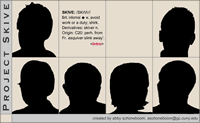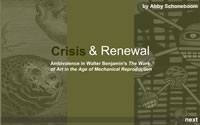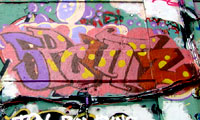Research Projects and Scholarly Papers
A sample of my current and recent research projects is given below. Please do not hesitate to contact me if you are interested in finding out more about a specific project.
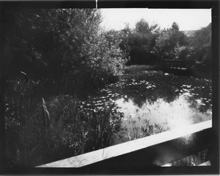
Pinhole photograph by SNCG Volunteer. View our blog post!
Scotswood Natural Community Garden (SNCG), an independent charity, is located in Newcastle upon Tyne in a neighbourhood ranked in the highest 10% for income, health, employment, education and training deprivation in the UK. This ESRC IAA funded project aims to engage garden users and stakeholders (volunteers, youth groups, staff, trustees, school staff and local people) in a participatory design and research process that explores the value of SCNG to its key users, working towards a shared vision for the future of the garden, developing a vision for a new facility that will expand the SCNG’s highly valued programme. The project team comprises architects Armelle Tardiveau and Daniel Mallo, sociologist/ethnographer Abigail Schoneboom, and research assistant Sophie Baldwin.
Project news:
- View our latest blog post, which narrates the current status of the project.
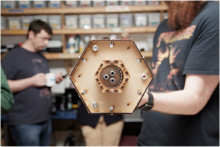
This visual ethnographic study, which was conducted at Newcastle upon Tyne’s Maker Space, explores the organizational and placemaking processes that emerge from a passion for making things. Placing a particular emphasis on this lively engagement, it examines how makers get beneath the surface of everyday objects and perceive their potential for transformation. Tracing the intimacy that makers develop with materials and the surrounding sense of social vitality and possibility, the study traces how place and organisation are continually renegotiated and given new meaning.
Contributing to the literature on sustainable ways of organizing that emerge from the interstices of everyday life and adding to a growing literature on space and organisation, the analysis infuses the metaphor of ‘parkour organization’ with a material sensibility drawn from scholarship on lively materials and ecological sustainability. The organization that emerges from the needs of makers to engage in a fluid conversation with materials is posited as a sometimes-tense yet fruitful negotiation that characterises Maker Space as vibrant and distinctly alive. This process is evaluated as in keeping with theories of urban development that disrupt ‘non-place’, promoting critical awareness of one’s surroundings, and of civic life, through sensual, richly textured engagement.
Publications/exhibits:
- Making Maker Space: An exploration of lively things, urban placemaking and organisation (revise and resubmit: first revision submitted April 2017 to Ephemera: Theory and Politics in Organization.

Cobalt Office Park is an edge city environment – it is neither urban in the traditional sense, nor a green-field science or technology park, yet constitutes a highly significant and under- researched type of place in people’s daily lives. Greater or lesser ecological sustainability can be enacted and take root in such spaces; the pilot project, conducted in summer 2014, therefore sought to engage Cobalt workers in optimising their work-life balance, as well as engaging local residents in extending existing sustainable practices in such places bordering their residential areas.
Phase I of the project involved three days of participatory research at the site, engaging employees and local community members in wildflower walks and gathering fieldnotes and interview testimony. This was followed by a temporary interactive exhibit in an inflatable structure where we presented alternative visions of how the site could be developed and invited feedback from the public. We are currently engaged in developing the project further.
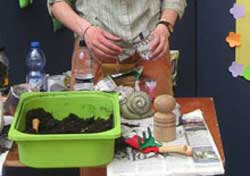
My seed-planting activity at the Sheffield Children's Festival won the 2012 VITAE NYE Public Engagement Competition.
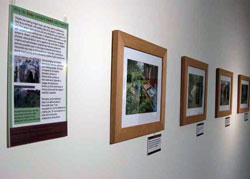
"Why do busy people need allotments?" an exhibit at the University of York, 2012, featured portraits by Julian May who is collaborating on the visual ethnographic part of the project.
Public engagement poster: 'Why busy people need allotments'.
[enlarged version]
There are currently an estimated 30 applicants for every UK allotment plot, with projected waiting times of up to 40 years in parts of the country (Jones, 2009).
This study explores the day to day life of the allotment, paying particular attention to the productive dimension of allotment activity, exploring how it interacts with and responds to contemporary wage labour.
I am currently in the process of writing up and presenting the research data, developing exhibits and interactive public engagement activities as well as journal articles.
Publications/exhibits:
- It makes you make the time: Allotment gardening and work intensification (revise and resubmit: first revision submitted May 2017 to Ethnography).
-'Working through the allotment' in Ephemera: Theory and Politics in Organization, Vol. 13, No. 1, pp. 137-50, February 2013.
-
'Why do busy people need allotments?' Photographic exhibit with Julian May, Art of Management Conference, University of York, UK, 4 -7 September 2012 (also exhibited 2016 at Newcastle City Library).
-
'Why do busy people need allotments?' Interactive learning activity as part of the Vitae NYE Box of Ideas showcase at Sheffield Children’s Festival, 7 July 2012. Winner of public engagement competition.
Conference papers and presentations:
-
'Allotment work? Exploring the boundary between work and leisure'. The York Management School Research Seminar Series,York, UK, 25 January 2012.
-
'Allotment work? Exploring the interface between ‘leisure’ gardening and labour'. University of Liverpool Management School and Keele University Ethnography Symposium, Cardiff, UK, 6 September 2011.
-
Working through the allotment. Free Work (an Ephemera conference), Senatsreservespeicher, Berlin, Germany, 11-13 May 2011.
- Allotment work? Theorising the relationship between allotments and wage labour. International Labour Process Conference, Leeds University, UK, 5-7 April 2011.
- 'Growing your own: Designing an ethnographic approach to study the form, function and feel of allotment work', presented at the
5th Annual Ethnography Symposium, Queen Mary, University of London, September 2nd, 2010.
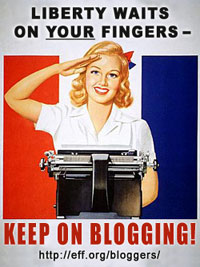
Anonymous workbloggers -- employees who write online diaries about their work -- are often simultaneously productive workers and savage critics of the organizational cultures in which they toil. Looking at how bloggers indulge their creative and political aspirations while "hiding out" in office jobs, this research assesses the potential of blogging to transcend individualized cynicism and contribute to the critical transformation of work. Broadly surveying media and organizational responses to the workblogging phenomenon, and engaging in ethnographic study of anonymous workbloggers on both sides of the Atlantic, my dissertation explores the relationship between emerging networked technologies and resistance. Considering workers as authors, it documents the diversion of significant creative and intellectual resources away from the labour process. Situating workbloggers within a rich tradition of iconoclastic literary and artistic responses to work, it explores whether embedded writers, in spite of their ambivalence about the alternative, can constitute an effective counter-hegemonic force.
Dissertation: Complete version [4.21MB]; Chapters 1 [667kB] | 2 [245kB] | 3 [1.24MB] | 4 [1.31MB] | 5 [2.15MB] | 6 [290kB] |7 [220kB] | Bibliography [242kB]
Papers/publications related to dissertation:
- 'The romance of the lowly clerk' in Organization (Sage Publications), currently available via online first, February 2014.
- 'Workblogging in a Facebook age' in Work, Employment & Society (Sage Publications), Vol. 25, No. 1, pp. 132-140, March 2011.
- 'Sleeping giants? Fired workbloggers and labour organization' in New Technology, Work and Employment (Wiley-Blackwell), 26(1) pp. 17-28, March 2011.
- 'Anonymous workbloggers and organizational coping strategies', book chapter in Latusek & Gerbasi (eds.), Trust and Technology in a Ubiquitous Modern Environment: Theoretical and Methodological Perspectives (IGI Global), pp.210-227, April 2010.
- 'The turn to Facebook? Adoption of emerging social networking technologies by anonymous workbloggers', presented at International Labour Process Conference, Rutgers University, USA, March 16, 2010.
- 'Technology policies with teeth: Can recalcitrant workbloggers be co-opted and controlled?', presented at International Labour Process Conference, Edinburgh, UK, April 7, 2009.
- 'Polyphony and the workblog: Using varied voices to build a critical consensus'. American Sociological Association Annual Conference, Boston, USA, August 1, 2008.
-
'The story of Petite Anglaise:
Celebrity workbloggers and workplace resistance', presented at Eastern
Sociological Society Annual Meeting, New York, February 21, 2008.
- 'Diary
of a working Boy: Creative resistance among anonymous workbloggers' in
Ethnography (Sage Publications), Vol. 8, No. 4, 403-423 (2007).
-
'Anonymous bloggers and organizational
coping strategies', presented at American Sociological Association Annual
Conference, Montreal, Canada, August 12, 2006.
Project Skive is an interactive multimedia piece that looks at the creative time-wasting efforts of six English white-collar workers, inviting people around the world to contribute stories of their own skives. Skiving, which derives from the French esquiver or "slink away," is an English slang term that includes all non-work activity engaged in during time when one is supposed to be working. The piece was featured recently as an art installation for No Time to Lose: A Search for Work/Life Balance, curated by Milena Placentile at Peacock Visual Arts Centre, Aberdeen, Scotland (13 June - 26 July 2008).
More information on Project Skive:
- Project Skive
(you are invited to add your skiving story!)
- Peacock Visual Arts summary
of the No Time To Lose show
- The NTTL Blog: Main
page and exhibition
photos/postings
- Project Skive background paper
and photos of vinyl | installation
Related Publications/Radio Interviews:
- 'Project Skive: Can a multimedia art exhibit function as an ethnography of workplace resistance?' in Creative Approaches to Research (RMIT Publishing). Vol. 3, No. 1, pp.3-15, June 2010.
- Featured in Placentile, M. and M. Vykoukal, Eds. No Time to Lose: A Search for Work/Life Balance. Peacock Visual Arts, Aberdeen, April 2010.
- Radio interviews on ABC Melbourne (May 2, 2010, also blog entry) & BBC Radio 5 (May 15, 2009)
Crisis and Renewal: Ambivalence in Walter Benjamin's Work of Art in the Age of Mechanical Reproduction
I recently read Enid Starkie's biography of Rimbaud and was gripped by the idea that the young poet wrote Le Bateau Ivre, my favorite poem, without having seen the sea. According to Starkie, the language in the poem was inspired in part by scientific and historical picture books of the day. I was able to obtain one of these books (Figuier's Ocean World) and to explore the connection with Benjamin's essay on mechanical reproduction by juxtaposing Rimbaud's verse and illustrations from Figuier's text. I then reflected on the "crisis" aspects of Benjamin's essay by delving into The Machine Stops, a prescient story by E.M. Forster that anticipates some of the negative aspects of the Internet age. It is a pleasant coincidence that Forster also deals with the theme of the sea and the extent to which we can know the sea without experiencing it. In my conclusion, I have tried to relate these two literary examples to current questions surrounding the potential for crisis and renewal in our increasingly technological society.
5Pointz: Portrait of a Graffiti Community
5Pointz is the name graffiti artists have given to a multi-story warehouse in Long Island City (LIC), which is one of the few remaining legal graffiti spots in New York. LIC is a run-down yet rapidly gentrifying neighborhood of abandoned factories, railroads, and expressways, just across the river from the gleaming skyscrapers of Manhattan. This study looks at how the graffiti artists organize themselves and explores the relationship between "outsider" artists and "insider" artists who rent studio space in the building, chronicling the graffiti artists' struggle to legitimize their art while remaining true to a hiphop-based culture that is inherently iconoclastic.
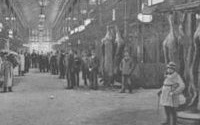
The sausage figures prominently in 19th century literature and was present at the birth of the existential novel. Pig and pork references color the writing of Dickens, Hamsun, Sartre, Camus, Bulgakov, and Dostoevsky, shattering the comfy world of the self-satisfied bourgeois and replacing it with something more, well, sausagey. This article looks beyond the taut and regular skin of urban existence to an offaly underside that is ready to burst through the seams at the slightest provocation.
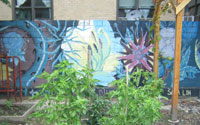
The ARROW vegetable garden is an improbable patch of bare earth that exists in amongst the warehouses and junkyards of Queens, its 20 grave-sized plots caged in by a tall iron fence that seems to have been put there to hold back the asphalt. This ethnographic study follows the handful of committed gardeners who keep the project going, remaining committed to its future and passionate about the personal and societal benefits of community gardening, in spite of dwindling membership and pressures to give up the space. The study concludes that, in a relatively low-income, time-scarce community, underuse of a community resource such as the ARROW vegetable garden does not necessarily signify lack of interest in or need for public greenspace.
The Great Dog Massacre
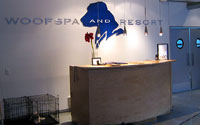
The title of this piece is borrowed from Robert Darnton’s The Great Cat Massacre, which draws on the account of an 18th-century printer, Nicolas Contat, who witnessed the ritual slaughter of cats as part of a workers’ rebellion against emerging inequality in the print houses. This project explores Manhattan’s pampered dog fad as mirroring, in a contemporary context, the situation described by Contat. Manhattan’s dog spas and luxury dog clothing stores exist side by side with growing income polarization, homelessness, and inner city deprivation. Juxtaposing footage of Woofspa, a luxury dog facility in the West Village, and a pack of junkyard dogs owned by a homeless former hot dog vendor, this piece reflects on the way in which we legitimize opulence in the face of extreme poverty. [Currently not available online]
